Climate and the underlying bedrock interact to create a diversity of soils
Soil The layer of chemically and biologically altered material that overlies bedrock or other unaltered material at Earth’s surface.
Climate indirectly affects the distributions of plants and animals through its influence on the development of soil, which provides the substratum for plant roots to grow and in which many animals burrow. Soil defies a simple definition, but we may describe it as the layer of chemically and biologically altered material that overlies bedrock or other unaltered material at Earth’s surface. Because the layer of bedrock that underlies soils plays a major role in determining the type of soil that will form above it, soil scientists call it the parent material.
Parent material The layer of bedrock that underlies soil and plays a major role in determining the type of soil that will form above it.
Soil Formation
Soil includes minerals derived from the parent material, modified minerals formed within the soil, organic material contributed by plants, air, and water within the pores of the soil, living roots of plants, microorganisms, and the larger worms and arthropods that make the soil their home. For example, if you have ever seen a recently excavated road cutting through a hillside, you may have observed that soils have distinct layers, called horizons, as shown in Figure 5.16. Soil horizons are categorized by the components and processes that occur at each level.
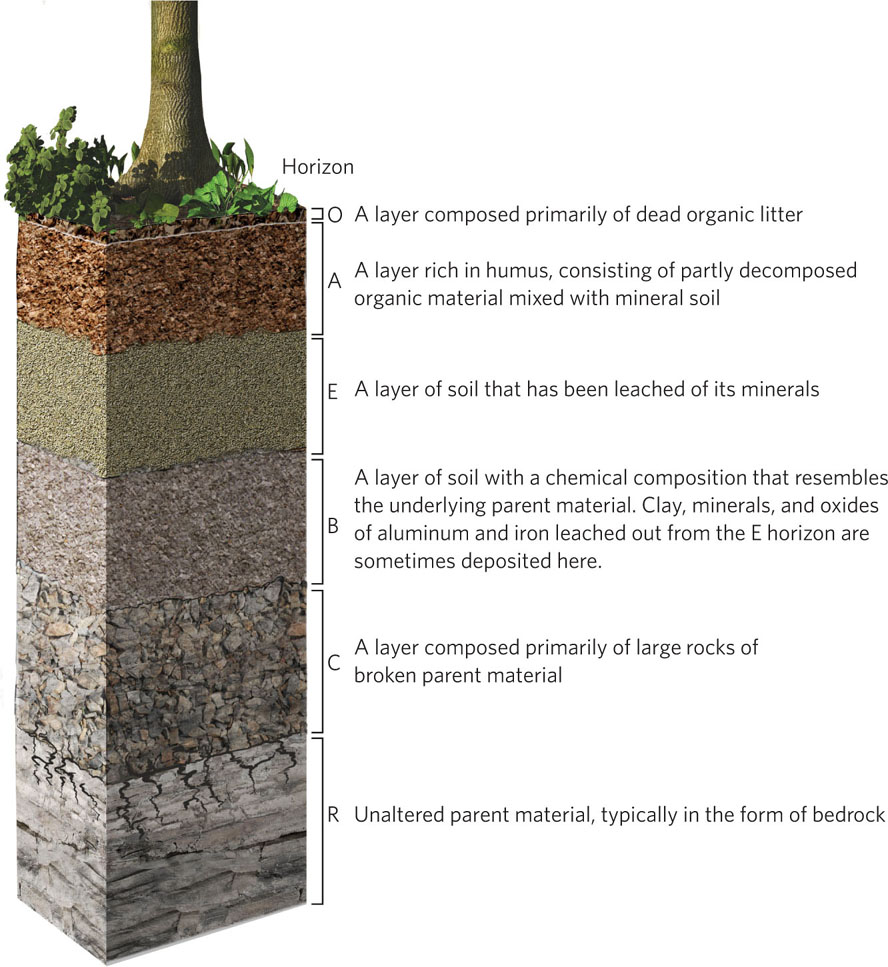
Horizon A distinct layer of soil.
Leaching A process in which groundwater removes some substances by dissolving them and moving them down through the soil to lower layers.
Soils exist in a dynamic state and their characteristics are determined by climate, parent material, vegetation, local topography, and, to some extent, age. Groundwater removes some substances by dissolving them and moving them down through the soil to lower layers, a process known as leaching. Other materials enter the soil from vegetation, in precipitation, as dust from above, and from the parent rock below. Where little rain falls, the parent material breaks down slowly, and sparse plant production means that little organic material is added to the soil. Thus, dry climates typically have shallow soils, with bedrock lying close to the surface. In places where decomposed bedrock and organic material erode as rapidly as they form, soils may not form at all. Soil development also stops short on alluvial deposits, where fresh layers of silt deposited each year by floodwaters bury older material. At the other extreme, soil formation proceeds rapidly in tropical climates, where chemical alteration of parent material may extend to depths of 100 m. Most soils of mid-latitude climates are intermediate in depth, extending to an average of about 1 m.
130
Weathering
Weathering The physical and chemical alteration of rock material near Earth’s surface.
Weathering is the physical and chemical alteration of rock material near Earth’s surface. Weathering occurs whenever surface water penetrates the parent material. In cold climates, for example, the repeated freezing and thawing of water in crevices causes the rock to break into smaller pieces and exposes a greater surface area of the rock to chemical reactions. The initial chemical alteration of the rock occurs when water dissolves some of the more soluble minerals, such as sodium chloride (NaCl) and calcium sulfate (CaSO4). Further chemical reactions continue the soil building process.
The weathering of granite illustrates some basic processes of soil formation. The minerals responsible for the grainy texture of granite—feldspar, mica, and quartz—consist of various combinations of oxides of aluminum, iron, silicon, magnesium, calcium, and potassium. The key aspect of the process of weathering is the displacement of many of these elements by hydrogen ions, followed by the reorganization of the remaining minerals into new types of minerals. The hydrogen ions involved in weathering are derived from two sources. One source is the carbonic acid that forms when carbon dioxide dissolves in rainwater, as discussed in Chapter 2. The other source of hydrogen ions is the decomposition of organic material in the soil itself. The metabolism of carbohydrates, for example, produces carbon dioxide. This carbon dioxide is converted into carbonic acid in water, which generates additional hydrogen ions.
131
Cation exchange capacity The ability of a soil to retain cations.
As granite weathers, many of the positively charged elements in feldspar and mica—such as Fe3+ and Ca2+—are replaced by hydrogen ions to form new, insoluble materials, such as the clay particles we discussed in Chapter 3. Clay particles are important to the water-holding capacity of soils. They accumulate negative charges on their surfaces that attract positively charged ions called cations. Cations—including calcium (Ca2+), magnesium (Mg 2+), potassium (K+), and sodium (Na+)—are important nutrients for plants. The ability of a soil to retain these cations, called its cation exchange capacity, provides an index to the fertility of that soil. Young soils have relatively few clay particles and little added organic material; this low cation exchange capacity leads to relatively low fertility. Older soils generally have a higher cation exchange capacity and therefore relatively high fertility. Soil fertility improves with time, up to a point. Eventually weathering breaks down clay particles, cation exchange capacity decreases, and soil fertility drops.
Podsolization
Podsolization A process occurring in acidic soils typical of cool, moist regions, where clay particles break down in the E horizon, and their soluble ions are transported down to the lower B horizon.
Under mild temperatures and moderate precipitation, sand grains and clay particles resist weathering and become stable components of the soil. This allows soils to retain relatively high fertility. However, in acidic soils typical of cool, moist regions, clay particles break down in the E horizon, and their soluble ions are transported down to the lower B horizon. This process, known as podsolization, reduces the fertility of the soil’s upper layers.
Acidic soils occur primarily in cool regions where needle-leaved trees such as spruces and firs dominate the forests. The slow decomposition of the spruce and fir needles produces organic acids that promote high concentrations of hydrogen ions. In the moist regions where podsolization occurs, rainfall usually exceeds evaporation. Because water continuously moves downward through the soil profile, little clay-forming material is transported upward from the weathered bedrock.
In North America, podsolization is most advanced under spruce and fir forests of New England, in the Great Lakes region, and across a wide belt of southern and western Canada. A typical profile of a highly podsolized soil, shown in Figure 5.17, reveals striking bands corresponding to the regions of leaching and redeposition. The A horizon is dark and rich in organic matter. It is underlain by a light-colored E horizon that has been leached of most of its clay, leaving behind sandy material that holds neither water nor nutrients well. One usually finds a dark band immediately below the E horizon. This is the uppermost layer of the B horizon, where iron and aluminum oxides are redeposited. Other, more mobile minerals may accumulate to some extent in lower parts of the B horizon, which then grades almost imperceptibly into a C horizon and the parent material.
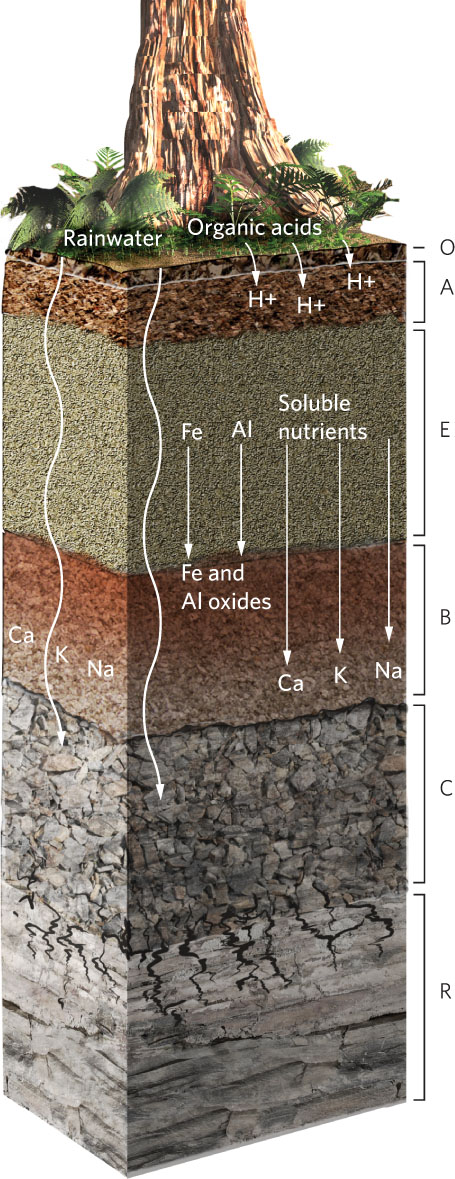
132
Laterization
In the warm, humid climates of many tropical and subtropical regions, soils weather to great depths. One of the most conspicuous features of weathering under these conditions is the breakdown of clay particles, which causes silicon to leach from the soil and leaves oxides of iron and aluminum to predominate throughout the soil profile—a process that is called laterization. The iron and aluminum oxides give such soils a characteristic reddish coloration as illustrated in Figure 5.18. Even though the rapid decomposition of organic material in tropical soils contributes an abundance of hydrogen ions, bases formed by the breakdown of clay particles neutralize them. Consequently, lateritic soils are not usually acidic, even though they may be deeply weathered. Regardless of the parent material, weathering reaches deepest, and laterization proceeds farthest, on low-lying soils, such as those of the Amazon basin, where highly weathered surface layers are not eroded away and the soil profiles are very old.
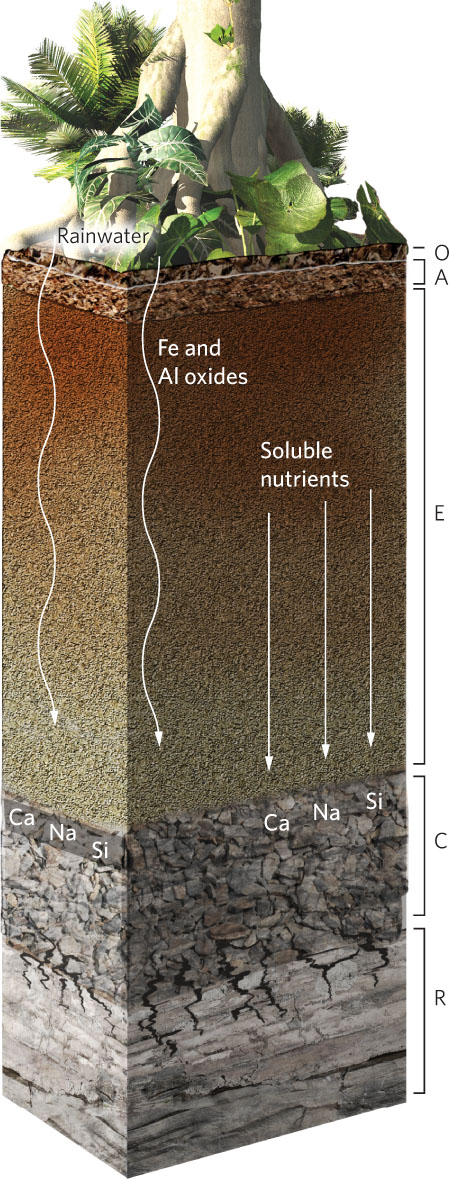
Laterization The breakdown of clay particles, which results in the leaching of silicon from the soil, leaving oxides of iron and aluminum to predominate throughout the soil profile.
Laterization causes many tropical soils to have a low cation exchange capacity. In the absence of clay and organic matter, mineral nutrients are readily leached from the soil. Where soils are deeply weathered, new minerals formed by the decomposition of the parent material are simply too far from the surface to contribute to soil fertility. In addition, heavy rainfall in the tropics keeps water moving down through the soil profile, preventing the upward movement of nutrients. In general, the deeper the ultimate sources of nutrients in the unaltered bedrock, the lower the fertility of the surface layers. The high productivity of tropical rainforests depends more on rapid cycling of nutrients close to the surface of the soil than on the nutrient content of the soil itself. Rich soils do, however, develop in many tropical regions, particularly in mountainous areas where erosion continually removes nutrient-depleted surface layers of soil, and in volcanic areas where the parent material of ash and lava is often rich in nutrients such as potassium.
From our discussion of soils, you can see that the composition of the soils present in various parts of the world depends on differences in climate, underlying parent material, and vegetation. In the next chapter, we will discuss how these regional differences in climate and the associated effects on soils affect the types of plants and animals that can live in each region.
133
ECOLOGY TODAY CONNECTING THE CONCEPTS
GLOBAL CLIMATE CHANGE
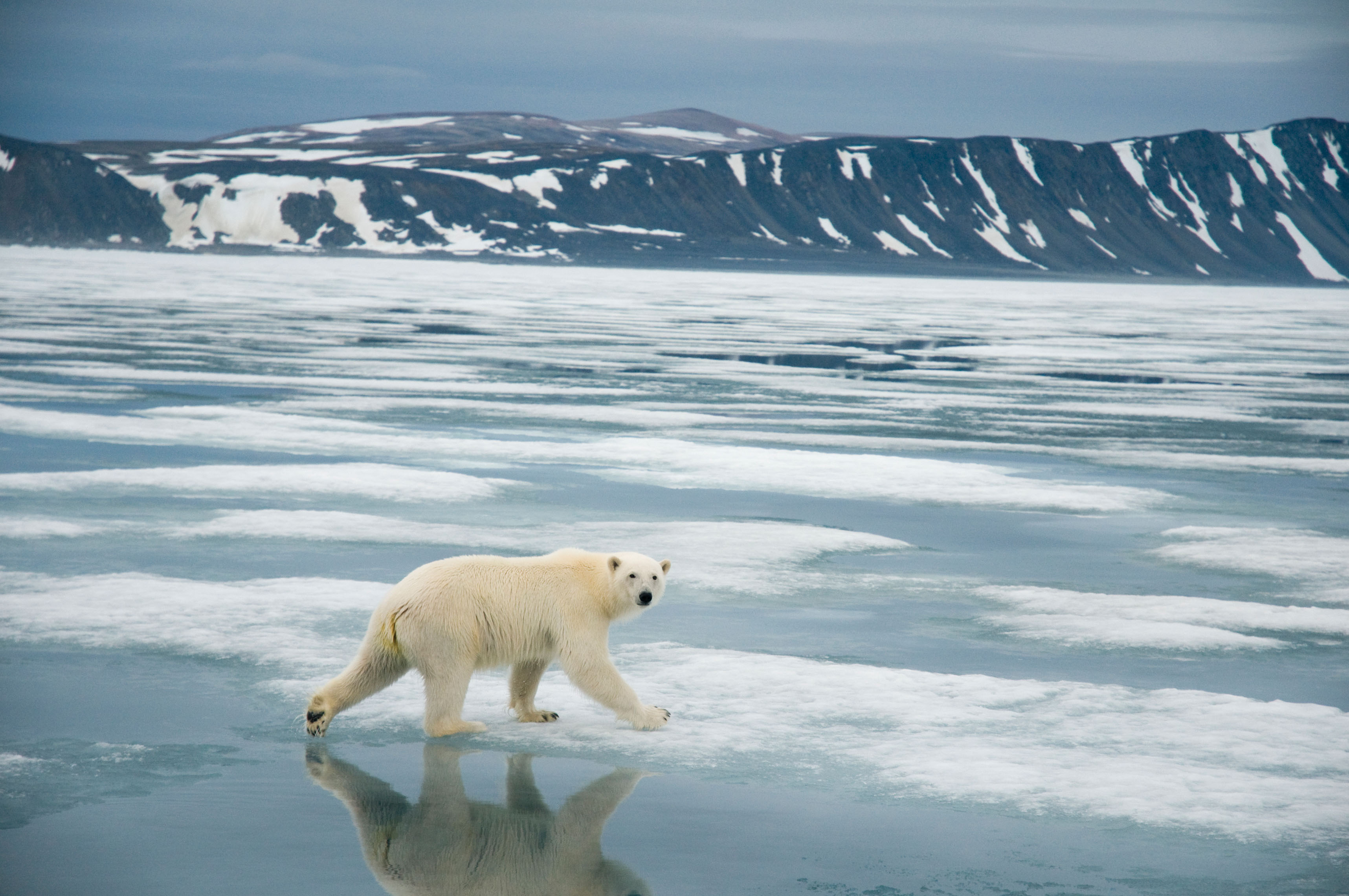
Global climate change A phenomenon that refers to changes in Earth’s climates including global warming, changes in the global distribution of precipitation and temperature, changes in the intensity of storms, and altered ocean circulation.
As we have seen in this chapter, a substantial number of interacting factors determine the different climates of the world. For example, the differential heating of Earth drives the movements of air and water, which are further modified by the Coriolis effect and the position of continents. Because these interactions are complex, any changes in these factors can have far-reaching effects on the entire system. Such is the case for global warming and global climate change. Global warming is the increase in the average temperature of the planet due to an increased concentration of greenhouse gases in the atmosphere. Global climate change is a much broader phenomenon that refers to changes in Earth’s climates and includes global warming, changes in the global distribution of precipitation and temperature, changes in the intensity of storms, and altered ocean circulation. Throughout the history of Earth, long periods of gradual global warming and cooling have been associated with substantial global climate change. During the past 2 centuries, however, human activities have caused a rapid change in conditions that have led to global warming and global climate change.
Permafrost A phenomenon where layers of soil are permanently frozen.
Global warming is a major driver of current changes in global climates. One direct impact is the increase in temperatures in many parts of the world, particularly at high latitudes in the Northern Hemisphere. The rise in temperature in these regions has had a wide range of effects. For example, in high latitudes and at high altitudes, the lower layers of soil may be permanently frozen, a phenomenon that is known as permafrost. Warmer temperatures cause these highly organic soils to thaw and begin decomposing. Because these soils are waterlogged and anaerobic, the decomposition produces methane, a greenhouse gas that can further contribute to global warming.
Increased temperatures also affect the amount of ice melting around the world. From 2006 to 2012, the polar ice cap that exists between the United States, Canada, Europe, and Russia became 45 percent smaller than its average size during the 1980s and 1990s. The remaining ice has also become thinner. The ice of Greenland and Antarctica is also melting. NASA scientists found, from 1992 to 2009, that the two regions lost an average of 475 gigatonnes (Gt) of ice per year and that the annual rate of ice loss is accelerating. Similarly, glaciers are melting in many regions of the world. In Montana’s Glacier National Park, for example, there were 150 glaciers in 1850. Today only 25 glaciers remain. All of this ice melting has caused sea levels to rise 220 mm since 1870 and scientists predict that continued melting could raise sea levels an additional 280 to 430 mm by the year 2100.
134
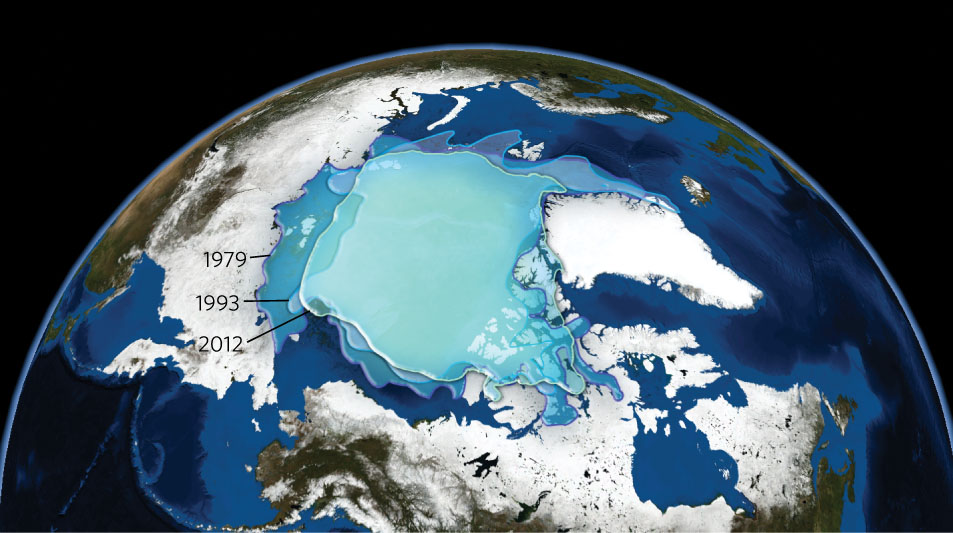
Because the complex nature of the global climate system can make it difficult to predict how climate will change in the coming decades, scientists have developed computer models that incorporate our best understanding of the processes that govern climate along with the changes that are being caused by increased atmospheric greenhouse gas concentrations. Although different models make somewhat different predictions, there is general agreement regarding several aspects of predicted change. For example, the increase in temperatures is expected to cause longer periods of hot weather and fewer days of extremely cold weather. Because heat is the driver of evaporation and air circulation that determine precipitation, precipitation patterns are also predicted to change across the globe, with some regions of the world receiving increased amounts of rain and snow while other regions receive less. The intensity of storms, such as hurricanes, is also predicted to increase due to an increased warming of the world’s oceans.
Ocean currents may also be affected by global warming. As we discussed earlier in this chapter, ocean currents are driven by the differential heating of Earth and, in turn, play a major role in determining the temperature of nearby continents. Of particular concern is the potential impact on thermohaline circulation. As you may recall, thermohaline circulation is the slow, deep circulation of ocean water around the globe that is driven by the dense, salty water that sinks near Greenland. With the increased melting of the polar ice cap and the ice sheets of Greenland, climate scientists are concerned that the water in the North Atlantic may not be dense enough to sink, and therefore may cause the thermohaline circulation to shut down. The disappearance of this deep-water current would effectively stop the circulation of warm water from the Gulf of Mexico to Europe and cause a substantial cooling of Europe—with potentially devastating consequences for the people and environment of that region.
SOURCES: Climate Change 2007: Synthesis Report. Fourth Assessment Report of the Intergovernmental Panel on Climate Change. http://www.ipcc.ch/pdf/assessment-report/ar4/syr/ar4_syr.pdf
Global Climate Change Impacts in the United States. 2009. U.S. Global Change Research Program. http://downloads.globalchange.gov/usimpacts/pdfs/climate-impacts-report.pdf